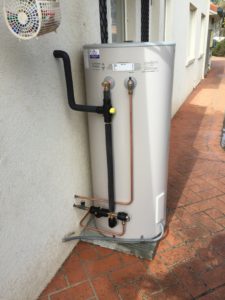
What is a Vacuum Relief Valve and how is it used with a water heater?
A Vacuum Relief Valve is a simple device that prevents back-siphonage of a water heater or storage tank. It is typically used on water heaters with cold water connections located near the bottom of the tank. If the building’s water line were shut down, the system can back-siphon the cold water line. The Vacuum Relief Valve is located above the water heater and will open to atmosphere when a back-siphon (vacuum) occurs. This allows air to enter at the vacuum relief valve and the heater/tank will not be drained down. This protects heaters from dry-firing the elements or burner.
Vacuum Relief Valves are also used on radiators to prevent losing water within the radiators if the system loses pressure or has been drained down.
Why are Vacuum Relief Valves not used much on top-feed water heaters?
Water heaters that have top connections will use a Dip-Tube that forces cold water to the bottom of the tank. A top-connect water heater is subject to a back-siphon vacuum but this is easily prevented by having a siphon hole located near the top of the dip tube. This hole will only allow water to back-siphon until the vacuum reaches the hole. Once the vacuum reaches the hole, it will draw air through the hole and the tank will not drain down. This “anti-siphon” feature is standard on top-fed water heaters and is typically located just a few inches from the top of the tank.
How does a Pressure Vacuum Breaker differ from a Vacuum Relief Valve?
A vacuum relief allows air to enter into the piping to prevent back-siphonage. In contrast, a Pressure Vacuum Breaker is designed to relieve a backflow of contaminated water and also function as an anti-siphon device. As the water begins to backflow, the Pressure Vacuum Breaker will open to create an anti-siphon point and discharge the backflow water from its relief port.
Can you please explain a Combination Pressure Reducing/Automatic Fill Valve for a closed loop system?
A closed loop heating system is typically operated at a system pressure that ranges from 20 – 30 PSI. Since incoming cold water supplies will have 40 PSI or greater, a pressure reducing valve must be used to regulate down to approximately 25 PSI. An Automatic Fill Valve will open when pressure drops below the set pressure. When incoming water refills the system (higher pressure injects water into the closed loop), the Fill Valve will close once the pressure setting is reached.
A Combination Valve will have all of these features built in. It is either a single or dual valve assembly that will regulate system pressure and provide automatic water fill. Most fill valves have a manual lever for quick-filling the system.
It is important to note that closed loop systems use treated water that is heated over and over. A closed loop system will experience certain issues if too much fresh water is entered into the system. Fresh water dilutes the boiler chemical treatment and brings in more calcium and minerals with each fill. This can cause scaling and corrosion of components. A closed loop system that keeps refilling usually has a leak in the pressurized piping that must be addressed.
How much condensate can a high efficiency water heater or boiler actually produce?
A condensing appliance can generate approximately 1 gallon of condensate per 100,000 BTU per hour. If you are installing a 500,000 BTU heater, it can generate up to 5 gallons per hour! Make sure you have provided for proper drainage of this combustion by-product.
Is condensate that is generated by a gas-fired appliance safe to dispose of down any drain? Or through a wall and directly dumped on the ground?
Combustion condensate is very acidic and should be neutralized before entering a cast iron drainage system or storm drain system. It is toxic and should not be discharged directly on to the earth either.
How is condensate “neutralized” prior to entering a drain?
Most manufacturers offer a version of a condensate neutralizer. They either use limestone chips or a block of calcium carbonate to offset the low pH, acidic condensate. These neutralizer assemblies can be for individual or multiple appliances and usually have a PVC housing or inline fitting.
How does a Pressure Relief Valve and Temperature & Pressure (T&P) Relief Valve differ?
A Temperature & Pressure (T&P) Relief Valve is typically used on a water heater producing 180°F or less. It has a high pressure spring normally rated at 125 or 150 PSI. It also has a temperature probe that will lift the seat at approximately 210°F (just before boiling).
Boilers operate at lower pressures and can generate temperatures over 210°F so they employ a Pressure-only Relief Valve. The pressure relief valve will typically be rated at 30 PSI but they are offered in many different PSI settings.
A couple of areas where these relief valves can be used interchangeably are on Pool heaters and Storage Tanks. Some manufacturers provide Pressure-only valves and others ship their heaters with T&P valves. Tankless heaters use a Pressure-only valve (no probe) but they also would be proper to use a T&P valve. It is hard to immerse the probe of a T&P valve in piping so the Pressure-only relief valve is mainly used.
If you are looking for a Hampshire Plumber or plumber in the surrounding area, call Euro Plumbing & Sewer today at (224) 678-9966. With our “On Time Guarantee” we will provide the highest quality service on your schedule!
